



No one likes the pooch that’s left behind on their abdomen after pregnancy or weight loss. Fortunately, a tummy tuck or abdominoplasty can restore the flat and firm tummy you’ve worked so hard for.
But not all abdominoplasties are created equal. Dr. Siamak Agha, top SoCal plastic surgeon and body contouring expert, offers so much more than the standard tummy tuck or his signature high-definition tummy tuck™.
Continue reading the rest of this article to learn about the various types of tummy tucks that Dr. Agha practices — and help you decide which one best suits you.

1 of 85

Before deciding on the best plastic surgery for your abdomen, it’s essential to better understand your abdominal anatomy and what criteria Dr. Agha follows in pursuing a beautiful core. Check out this blog post to learn more about the characteristics of a beautiful abdomen.
Who Benefits from a Mini Tummy Tuck?
The mini tummy tuck is recommended for patients with mild abdominal skin laxity who want to smooth out their lower abdominal area. Typical patients have no upper abdominal skin excess with minimal abdominal muscle separation (recti diastasis).
Because they have minimal tummy laxity, mini tummy tuck patients only need lower abdominal skin removal to solve their belly woes.
How is a Mini Tummy Tuck Done?
Dr. Agha makes sure that he customizes the mini tummy tuck according to his patient’s needs. Often, he combines partial abdominoplasty with liposculpture to redefine the abdominal contour.

Unlike other surgeons, Dr. Agha also repairs abdominal muscle separation through a mini tummy tuck. Some of his modified techniques include:
Get more details about Dr. Agha’s mini tummy tuck procedures in this page.
A liposuction tummy tuck, also referred to as lipo-abdominoplasty, ensures that you achieve a flatter stomach and the ideal contour you want for your belly. It is a relatively new technique described by Dr. Saldengo, a Brazilian plastic surgeon.
In the traditional tummy tuck, liposuction is limited to the hips and waist because of the risk of damaging blood vessels in the abdomen. A liposuction tummy tuck has a more aggressive liposuction technique, although blood vessels are kept intact to make healing and recovery easier.
A liposuction tummy tuck provides an overall better aesthetic look for people who want to overhaul their body contour.
Who Benefits from a Liposuction Tummy Tuck?
Not all patients require a liposuction tummy tuck. Most only need liposuction of the waist coupled with a high-definition tummy tuck to achieve lasting results.
But some patients have loose abdominal skin and tissue in addition to a thick layer of fat above the abdominal muscles. Though a traditional tummy tuck can take care of the loose skin and tissue, it won’t thin out the overlying fatty layer on the muscle.
Lipo-abdominoplasty is best for these patients, as it combines a tummy tuck to remove excess abdominal skin and liposuction to reduce abdominal fat and tissue beneath the skin layer.Not all patients require a liposuction tummy tuck. Most only need liposuction of the waist coupled with a high-definition tummy tuck to achieve lasting results.
But some patients have loose abdominal skin and tissue in addition to a thick layer of fat above the abdominal muscles. Though a traditional tummy tuck can take care of the loose skin and tissue, it won’t thin out the overlying fatty layer on the muscle.
Lipo-abdominoplasty is best for these patients, as it combines a tummy tuck to remove excess abdominal skin and liposuction to reduce abdominal fat and tissue beneath the skin layer.
How is a Liposuction Tummy Tuck Done?
Not all tummy tucks are combined with liposuction. In fact, liposuction is an optional but safe component, as it is used for contouring and shaping the body alongside a tummy tuck.
But now, many people are opting to combine these two procedures to attain the abdomen they want.
Here’s how it’s done:
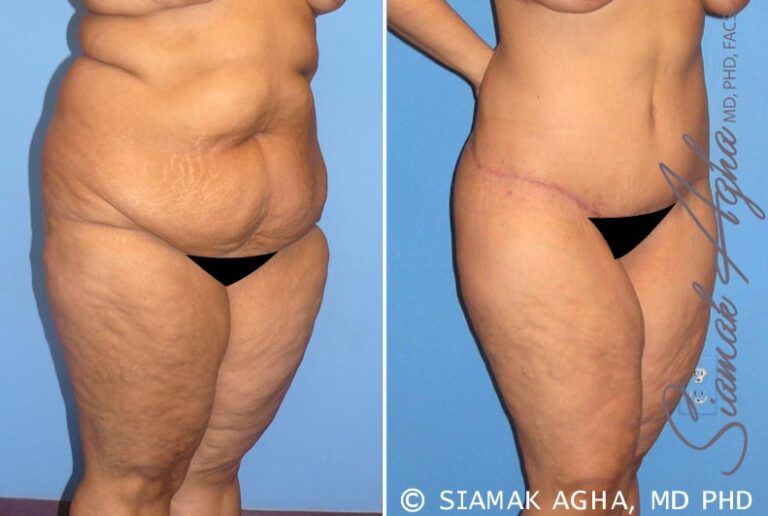

Like a full tummy tuck, the extended tummy tuck involves muscle tightening, abdominal skin excision, and liposuction. It is pretty much the same as the full tummy tuck, but the incision extends past the waists and removes the extra skin from the waists, hips, and love handles.
As such, it reshapes the body’s hip region in a much better way than the full tummy tuck. One can say that it’s more extensive than the standard full tummy tuck but less invasive than a circumferential tummy tuck.
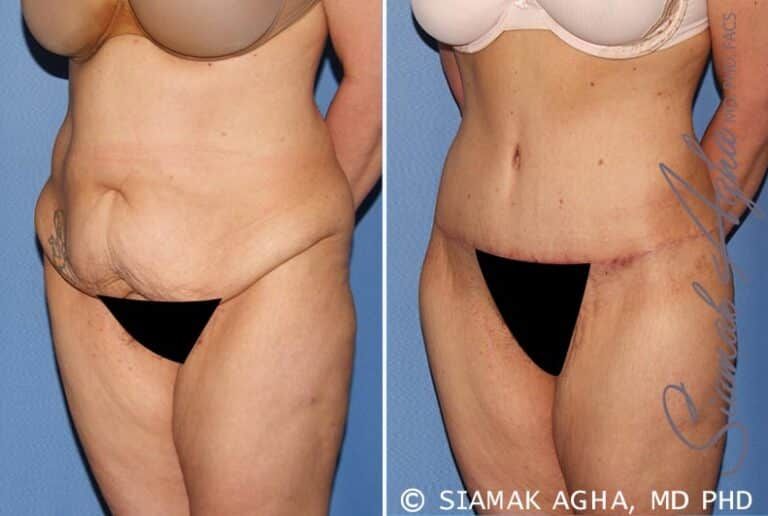
Who Benefits from an Extended Tummy Tuck?
The extended tummy tuck is best performed on patients with significant abdominal and waist skin laxity, such as those who had massive weight loss or multiple pregnancies.
How is an Extended Tummy Tuck Done?
Here’s how Dr. Agha performs your extended tummy tuck:
The whole procedure takes roughly three to four hours.
In some cases, the extended abdominoplasty can be combined with an anterior (front) thigh lift or outer thigh lift to reduce waist excess, lift the outer and front of areas of the thighs, and correct the appearance of dimples and cellulite. It fixes not only your front but also your sides to help you attain an hourglass figure.
Make sure that you follow Dr. Agha’s recovery plan to ensure safe and fast healing.
If you are on the heavier side but still want to flatten and reshape your belly, good news: you can get a plus size tummy tuck!
Designed for individuals with a larger body type, the plus size tummy tuck gets rid of excess fat, skin, and tissue and tightens your abdominal muscles so that you still get a confidence boost from your flatter tummy.
It will also eliminate hanging skin folds that cause chafing, make your clothes fit better, and even make exercise a lot easier to do after your recovery.
Who Benefits from a Plus Size Tummy Tuck?
Most people getting a plus size tummy tuck have lost a lot of weight but are still on the overweight side of the scale.
You can get this type of tummy tuck if you are medically healthy to undergo elective surgery despite your weight. You should not have any serious chronic illnesses, like asthma, diabetes, or heart disease.
How is a Plus Size Tummy Tuck Done?
Here’s how Dr. Agha performs your plus size tummy tuck:
The whole procedure takes roughly three to four hours.
In some cases, the extended abdominoplasty can be combined with an anterior (front) thigh lift or outer thigh lift to reduce waist excess, lift the outer and front of areas of the thighs, and correct the appearance of dimples and cellulite. It fixes not only your front but also your sides to help you attain an hourglass figure.
Make sure that you follow Dr. Agha’s recovery plan to ensure safe and fast healing.

Also known as a belt lipectomy, the circumferential tummy tuck addresses loose hanging skin on the lower body — the abdomen, waist, lower back, and buttocks.
Though many plastic surgeons refer to the circumferential tummy tuck and lower body lift interchangeably, they are entirely different.
Dr. Agha’s lower body lift is far more complex. It often includes a tummy tuck, anterior and outer thigh lift, pubic lift, waist and lower back skin excision, buttock lift and buttock augmentation, and lipocontouring.
On the other hand, the circumferential tummy tuck mostly includes a tummy tuck, waist reduction, and buttock lift only.

Who Benefits from a Circumferential Tummy Tuck?
Since the circumferential tummy tuck is much more invasive than a standard tummy tuck, it is only recommended for people with marked skin laxity due to massive weight loss, liposuction, or even aging.
It may take some time for patients to recover from the circumferential tummy tuck, but many of them report excellent results in the hands of an expert body contouring surgeon.
How is a CircumferentialTummy Tuck Done?
Here’s how Dr. Agha does a circumferential tummy tuck:
Since the circumferential tummy tuck is pretty extensive, you’ll need to have professional caregivers to help and care for you.
Less common than other types of tummy tuck, the inverted-T abdominoplasty gets rid of the fullness of your waists so that you can unravel your hourglass shape.
It combines a horizontal incision over the lower abdomen with a vertical one on the abdomen, creating an inverted-T shape, hence its name.
Although the procedure produces an attractive abdominal contour, it puts an unsightly and visible scar in the middle of your abdomen. For this reason, Dr. Agha tries his best not to employ this procedure unless it is absolutely needed and wanted by the patient.
Who Benefits from an Inverted-T Abdominoplasty?
The fleur-de-lis tummy tuck is done on patients who lost a significant amount of weight and have severe abdominal skin excess, thus needing a substantial quantity of skin and tissue removed.
Patients who opt for this procedure often have vertical and circumferential looseness of abdominal skin and tissues. By removing the excess skin, they get to enjoy a contoured hourglass figure.
How is a Fleur-de-Lis Abdominoplasty Done?
Here’s how a fleur-de-lis tummy tuck is done:
Although some patients sometimes desire fleur-de-lis abdominoplasty, a better alternative approach is flankplasty. It removes the excess skin and fat of the flanks by placing a vertical incision on each side.
These incisions are better placed and also offer tightening of the skin of the abdomen and back circumferentially.
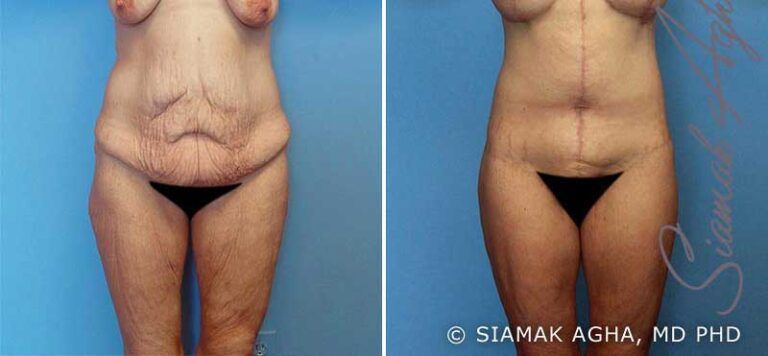

Panniculectomy is a procedure that corrects the appearance of an overhanging pannus — the excess skin and fatty tissue on your lower abdomen that often sags and covers the pubic area. It is usually caused by massive weight loss.
Who Benefits from a Panniculectomy?
A panniculectomy is recommended for patients with excess skin and subcutaneous fat on their lower abdomen. More often than not, these people also develop rashes and infections due to the excessive level of skin laxity in their lower abs.
Most doctors prescribe antibiotics and topical creams to help alleviate the symptoms. If these don’t work, patients are often referred to a board-certified plastic surgeon to consider getting a panniculectomy.
Depending on the medical necessity and severity of the condition, the procedure may be covered by your insurance company. Most of the time, insurance covers panniculectomy if it’s to alleviate the following:
To prove that you have any of these conditions, insurance companies often require dated photographs of the pannus hanging over the pubis and elevated to expose skin infection or irritation.
Your primary physician should also provide office notes reflecting the presence of chronic skin infection and irritation over six months, including all the treatments and medications prescribed to no avail.
The policies differ per insurance company, so make sure that you contact your insurance provider if you’re contemplating getting a panniculectomy.
How is a Panniculectomy Done?
Here’s how a panniculectomy is performed:
Though a panniculectomy can tighten your lower abdomen, it usually does not provide a full correction by itself. It is best combined with a standard tummy tuck, extended tummy tuck, or circumferential tummy tuck for optimum results.
Most tummy tuck procedures address skin laxity issues in your upper and lower abdomen. But what if your problem lies in the lower chest or upper abdomen? These patients often have breasts that are too low on the chest or have an upper abdominal roll below the breasts.
In such cases, a traditional tummy tuck won’t work well on the upper abdominal laxity. Instead, a reverse tummy tuck might just be what you need.
Made to address upper abdominal skin laxity issues, a reverse tummy tuck removes excess skin and fat on your upper abdomen and lower chest just below the breasts. The skin is then vertically pulled upwards towards the breasts.
It is like a mini-tummy tuck done upside down, with the incision made along the inframammary fold — the crease underneath the breasts.
Compared to other tummy tuck types, this procedure is relatively uncommon and is often done together with a breast reduction, breast lift, breast lift with implants, or upper body lift.
As such, it does not leave any additional scarring in the lower abdominal area. This makes it easier to conceal under a bra or bikini top.
You also don’t have to worry much about complications because the reverse tummy tuck does not interrupt blood supply.
Who Benefits from a Reverse Tummy Tuck?
Patients considered good candidates for a reverse tummy tuck are those with significant skin laxity in the upper abdomen and minimal skin laxity in the lower abdomen.
This is common among people who recently lost a significant amount of weight either through natural weight loss or bariatric surgery. It can also be done on post-pregnancy women who developed excess skin on their upper abs.
Because the reverse tummy tuck isn’t for everyone, it is best to consult a board-certified plastic surgeon specializing in body contouring to know if you are fit for this procedure. Dr. Agha has performed over 100 reverse tummy tuck cases for both men and women.
How is a Reverse Tummy Tuck Done?
Check out how Dr. Agha performs a reverse abdominoplasty:
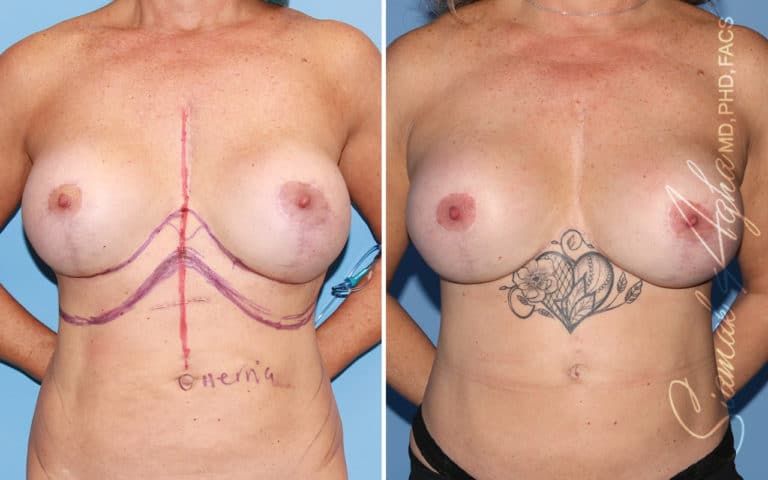

The tummy tuck may be one of the most popular cosmetic surgeries in the United States, but that does not mean all the operations end up being successful.
While most patients are delighted with their results, some of them encounter issues such as:
If you encounter any of these problems, then you might want to request a tummy tuck revision.
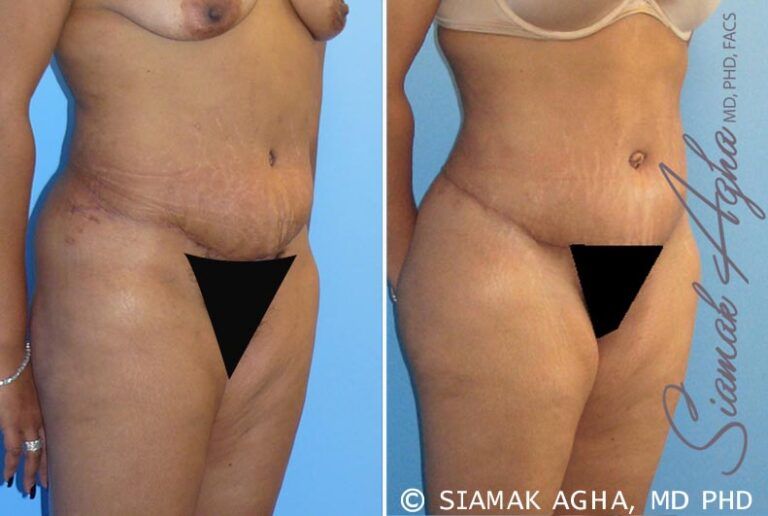
Who Benefits from a Tummy Tuck Revision?
People who want to get a tummy tuck revision are dissatisfied with the results of their previous tummy tucks with another surgeon.
There are plenty of reasons for dissatisfaction, but here are some of the most common ones:
How is a Tummy Tuck Revision Done?
Every patient has a different concern, so there’s no standard procedure for a tummy tuck revision.
Instead, Dr. Agha looks at your tummy tuck results to determine what the next steps are. He focuses on what was done and what needs to be altered to help you achieve a more aesthetically pleasing result.
The most common issues that Dr. Agha solves are:
Sometimes, the issues you’re experiencing may not be directly related to a tummy tuck. Some patients may need additional liposuction, reshaping of the mons pubis, and other procedures to enhance their abdomen’s appearance.
Not sure which tummy tuck or additional procedure is right for you? Visit The Aesthetic Centers and consult with Dr. Agha to know your options and help you make an informed decision.
With Dr. Agha’s years of experience doing tummy tuck surgeries combined with his dedication to his craft, we can ensure your safety and satisfaction in the outcome of your abdominoplasty.
Get a private and personalized consultation at our beautiful practice in Newport Beach, CA.
3701 Birch St. #200, Newport Beach, CA 92660
By providing a telephone number and submitting the form you are consenting to be contacted by SMS text message. Message & data rates may apply. Reply STOP to opt out of further messaging.
If you would like to know more about how your data will be used, please review our Privacy Policy.